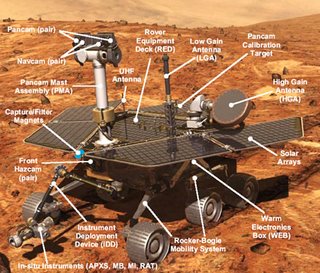The instruments carried by them include a Panoramic Camera (for determining the mineralogy, texture, and structure of the local terrain), magnets (for collecting magnetic dust particles), a Microscopic Imager (for obtaining high-resolution images of rocks and soils) and a Rock Abrasion Tool (for removing dusty and weathered rock surfaces).
Sorry to remind every one of our course work but one of the notable features of the rovers are the technologies used for autonomous planetary mobility that enable the rovers to make decisions and avoid hazards on their own. The system takes pictures of the nearby terrain, generate 3-D terrain maps and then plot dozens of possible paths before the rover chooses the shortest, safest path toward the programmed geographical goal.
The rovers may be light years away from us, but they are constantly improving as new software is uploaded to them frequently, applying whatever new knowledge we learn back here to help them in their mission. Even so, much technological advancements are made in hardware and could not be implemented to Spirit and
References: Mars Exploration Rover Mission Website http://www.space.com/marsrover/
Leaw Tiew Liang, U036391E


1 comment:
Hi, just would like to add some points to space exploration robots. In my opinion, I think that they are a technological marvel and a feat for mankind. The pioneer engineers and scientists spent millions of dollars into developing these robots, without knowing the outcome.
The latest Mars Rovers is multi-capable, able to conducts various research and experiments, and navigate through most kinds of terrains. One question though, it seems that most space robots are actively engaged with Mars. How about the other planets? To my knowledge, the others mainly explore the other planets from the orbit.Thanks.
Rgds,
Ng Chin Ling (U047690E)
Post a Comment